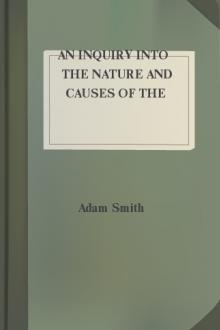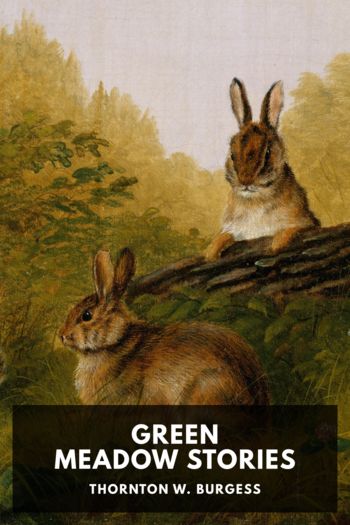The Wealth of Nations by Adam Smith (the best motivational books .TXT) 📕

- Author: Adam Smith
Book online «The Wealth of Nations by Adam Smith (the best motivational books .TXT) 📕». Author Adam Smith
9 Ann., c. 11. ↩
This passage, from the beginning of the paragraph, is quoted at length below, here. ↩
John Smith, Memoirs of Wool, vol. i, p. 25, explains that the words “It shall be felony to carry away any wool out of the realm until it be otherwise ordained” do not imply a perpetual prohibition. ↩
The same words occur above, here. ↩
Ed. 1 does not contain “etc.” ↩
The arithmetic is slightly at fault. It should be, “happened to lose a fourth, a fifth, or a sixth part of its former value.” ↩
Below, here. ↩
Above, here. ↩
Recherches sur la Population, pp. 293–304. ↩
Essai sur les monnoies ou réflections sur le rapport entre l’argent et les denrées, 1746, esp. p. 181 of the “Variations dans les prix.” ↩
Above, here. ↩
Lectures, pp. 159, 164. ↩
Ed. 1 does not contain “but.” ↩
C. 8. ↩
C. 5. The quotations from this Act and from 4 Hen. VII, c. 8, are not quite verbatim. ↩
“Dr. Howell in his History of the World, vol. ii, p. 222, relates ‘that Queen Elizabeth, in this third year of her reign, was presented with a pair of black knit silk stockings by her silk woman, Mrs. Mountague, and thenceforth she never wore cloth ones any more.’ This eminent author adds ‘that King Henry VIII, that magnificent and expensive Prince, wore ordinarily cloth hose, except there came from Spain, by great chance, a pair of silk stockings; for Spain very early abounded in silk. His son, King Edward VI, was presented with a pair of long Spanish silk stockings by his merchant, Sir Thomas Gresham, and the present was then much taken notice of.’ Thus it is plain that the invention of knit silk stockings originally came from Spain. Others relate that one William Rider, an apprentice on London Bridge, seeing at the house of an Italian merchant a pair of knit worsted stockings from Mantua, made with great skill a pair exactly like them, which he presented in the year 1564 to William Earl of Pembroke, and were the first of that kind worn in England.” —Adam Anderson, Historical and Chronological Deduction of the Origin of Commerce, 1764, AD 1561 ↩
Above, here through here. ↩
Towards the end of chapter X the same words occur, omitting “very.” ↩
Above, here. ↩
Above, here through here. ↩
As is explained above, here, the prices from 1202 to 1597 are collected from Fleetwood (Chronicon Preciosum, 1707, pp. 77–124), and from 1598 to 1601 they are from the Eton College account without any reduction for the size of the Windsor quarter or the quality of the wheat, and consequently identical with those given in this table, as to which see this note. ↩
In the reduction of the ancient money to the eighteenth century standard the tabel in Martin Folkes (Table of English Sliver Coins, 1745, p. 142) appears to have been follwed. Approximate figures are aimed at (e.g., the factor 3 does duty both for 2906 and 2871), and the error is not always uniform e.g., between 1464 and 1497 some of the sums appear to have been multiplied by the approximate 1½ and others by the exact 155. ↩
This should be 2s. 7¼d. The mistake is evidently due to the 3s. 4d. belonging to the year 1287 having been erroneously added in. ↩
Sic in all editions. More convenient to the unpractised eye in adding up than “½.” ↩
“And sometime xxs. as H. Knighton.” —Fleetwood, Chronicon Preciosum, p. 82 ↩
Miscopied: it is £2 13s. 4d. in Fleetwood, Chronicon Preciosum, p. 92. ↩
Obviously a mistake for £2 11s. 4d. ↩
This should be 17s. 7d. here and in the next column. Eds. 1 and 2 read “12s. 7d.,” a mistake of £1 having been made in the addition. ↩
This should obviously be 10s. ⁵⁄₂₄d. Eds. 1 and 2 read “£6 5s. 1d.” for the total and “10s. 5d.” for the average, in consequence of the mistake mentioned in the preceding note. ↩
Miscopied: it is £2 13s. 4d. in Fleetwood, Chronicon Preciosum, p. 123. ↩
See this note. ↩
Eds. 1 and 2 read £2 4s. 9⅓d., the 89s. left over after dividing the pounds having been inadvertently divided by 20 instead of by 12. ↩
The list of prices, but not the division into periods, is apparently copied from Charles Smith (Tracts on the Corn Trade, 1766, pp. 97–102 cp. pp. 43, 104), who, however, states that it had been previously published, p. 96. ↩
Wanting in the account for the years 1642–1645. The year 1646 supplied by Bishop Fleetwood. —Smith ↩
This should be ⁹⁄₃₂. ↩
Lectures, p. 181. ↩
Eds. 1 and 2 place the “only” here. ↩
“Ce n’est pas cette maison qui produit elle-même ces mille francs. … Le loyer d’une maison n’est point pour la





Comments (0)